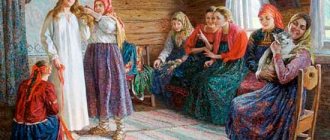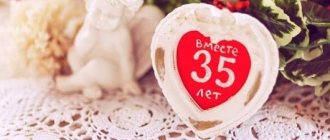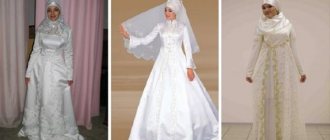In the old days, a headdress was the most significant and elegant item of a woman's costume. He could tell a lot about his owner - about her age, marital and social status, and even whether she had children. About the most unusual headdresses of Russian women - in the material of the portal "Culture.RF".
Women's festive costume. Nizhny Novgorod province. Photo: narodko.ru
Kokoshnik. Photo: lebrecht.co
Women's festive costume. Bryansk province. Photo: glebushkin.ru
In Rus', girls wore rather simple-shaped headbands and wreaths (crowns), leaving the crown and braid open. On the wedding day, the girl’s braid was unraveled and placed around her head, that is, “twisted.” From this ritual the expression “to entice a girl” was born, that is, to marry her to yourself. The tradition of covering the head was based on the ancient idea that hair absorbs negative energy. The girl, however, could take risks by showing off her braid to potential suitors, but a bare-haired wife would bring shame and misfortune to the whole family. The hair, styled “woman-style,” was covered with a cap that was pulled together at the back of the head—a povoinik or volosnik. On top they put on a headdress, which, unlike a girl’s, had a complex design. On average, such a garment consisted of four to ten removable parts.
Headdresses of the Russian south
The border between the Great Russian North and South ran through the territory of the modern Moscow region. Ethnographers include Vladimir and Tver in northern Rus', and Tula and Ryazan in southern Russia. Moscow itself was influenced by the cultural traditions of both regions.
Women's peasant costume in the southern regions was fundamentally different from the northern one. The agricultural south was more conservative. The peasants here generally lived poorer than in the Russian North, where trade with foreign merchants was active. Until the beginning of the 20th century, in southern Russian villages they wore the oldest type of Russian costume - a checkered ponyova (a waist-length garment like a skirt) and a long shirt, the decorated hem of which peeked out from under the ponyova. The silhouette of the southern Russian outfit resembled a barrel; it was combined with magpies and kichkas - headdresses distinguished by a variety of styles and complexity of design.
Original accessories for brides: wedding hats
Designers offer brides the most sophisticated and elegant styles. Wedding trends are also changeable, but, nevertheless, there are several favorites that are worth taking a closer look at.
But first, about the advantages of these models over veils. The ritual of marriage itself is becoming increasingly secular. People walk down the aisle in original dresses, stylized ceremonies are in fashion (for example, those inspired by the 60s or), today you can exchange rings in the most unusual places - even on exotic islands.
That is why original accessories are actively coming into fashion. The canonical and most universal style in this trend is the miniature “tablet”; it suits almost everyone and allows you to demonstrate luxurious styling. It can be decorated with anything - from an antique or veil to fresh flowers.
Look how elegant the wedding hats are in these photos:
Such models, among other things, perfectly balance the proportions of the outfit, especially if you have chosen a dress with a wide and luxurious hem. A veil, in this case, will certainly make you look like a cake prepared for dessert.
Weddings with such a hat can be designed in any style. Tight-fitting and cropped outfits will look most elegant. The “pill” style itself is a vintage idea from the 60s, when the proportions of a woman’s figure were the main criterion when sewing a dress.
The classic version is a model with a brim and a luxuriously decorated crown, also perfect for tight-fitting, both short and long dresses. In this case, it is important that the headdress does not “draw” all the attention to itself, leaving your figure and face as the main areas of attention.
These models are the most difficult to find even among the widest selection of ready-made accessories for brides. It is better to look for a master who will make such a model personally for you to order. Translucent and airy textures and voluminous decor, by the way, perfectly emphasize the graceful proportions of the entire figure.
Important point. When choosing wide-brimmed models, you should never give preference to synthetic materials. On your wedding day, you will probably be photographed a lot, and synthetics invariably create the effect of inexpensive shine. Natural chiffon and lace, individual style... Yes, it's not cheap. You are unlikely to wear this hat again, but it will be perfectly preserved as an inheritance for your daughter or granddaughter, along with excellent photographs.
Kika horned
The horned kichka is the headdress of peasant women in the Bogoslovshchina district of the Mikhailovsky district of the Ryazan province. The end of the 19th - beginning of the 20th centuries. Photo: Ryazan Historical and Architectural Museum-Reserve.
Peasant woman of the Ryazan province in a horned kitty. Photo: Fund of the Russian Ethnographic Museum (REM).
Peasant woman of the Ryazan province in a horned kitty. Photo: Fund of the Russian Ethnographic Museum (REM).
The word “kika” comes from the Old Slavonic “kyka” - “hair”. This is one of the oldest headdresses, which dates back to the images of female pagan deities. In the minds of the Slavs, horns were a symbol of fertility, therefore only a “manly woman” could wear them. In most regions, a woman received the right to wear a horned pussy after the birth of her first child. They wore a kika both on weekdays and on holidays. To hold the massive headdress (the horns could reach 20–30 centimeters in height), the woman had to raise her head high. This is how the word “boast” appeared - to walk with your nose in the air.
The clergy actively fought against pagan paraphernalia: women were forbidden to attend church wearing horned kicks. By the beginning of the 19th century, this headdress had practically disappeared from use, but in the Ryazan province it was worn until the 20th century. Even the ditty has been preserved:
Ryazan horns I will never throw them away. I will eat only chaff, but I will not throw away my horns!
What kind of dress for women does the Orthodox Church allow?
Clothing for a church wedding for a married couple.
If a girl is proposed to get married, then the first thing she thinks about is her wedding dress. What a great responsibility falls on a young lady if she has to undergo a complex wedding ceremony. It is necessary to select wedding dresses that will be beautiful, elegant, and modest, and that will meet all the requirements of the Orthodox Church.
There are certain instructions that help you choose a wedding dress correctly and responsibly:
Pay attention to the color of the wedding dress itself. The most harmonious option would be white, since it fits the definition of a bride perfectly.
After all, she is innocent, pure and immaculate. Recently, bright and rich colors have become increasingly popular. In fact, the church prohibits them. Therefore, it is unacceptable to appear at the ceremony in a red or purple outfit. If you do not want to settle on a white shade, then you can decide on the basis of pastel colors. For example, ivory or champagne. The openness of the outfit itself - a deep neckline, an open back, and bare legs are strictly prohibited. When trying on the dress itself, carefully inspect yourself so that there are no open spots. The Church allows short sleeves, but does not encourage thin straps. It is better that your shoulders are covered. The material from which the outfit is made is not discussed. In this regard, there is a lot of room for choice and flight of fancy. Both bright and glossy satin and muted elegant lace are suitable. All of these options will be equally good. The style doesn't matter at all. The only requirement is modesty. Otherwise, you can fantasize and select the tailoring that best suits your body type and height of the bride. There are no restrictions on this matter. Very often, brides buy dresses with a long train. All this is connected with foreign films. Such outfits are appropriate and are a prerequisite for a wedding in the Catholic Church. Orthodox clergy do not set such strict conditions regarding this issue.
Married
Dress for a wedding in a church, photo.
Often, an already married family, after a certain amount of time, decides to get married again, cementing their union in heaven. For them, the clergy make the same demands as for a very young couple and family.
When choosing an outfit, the only limitation is the color scheme. A woman who has been in a family relationship for a long time should not wear a wedding dress. It will look ridiculous on her. The white shade has long been associated with purity and innocence. In this case it would be inappropriate.
Unmarried
A girl who has never been married should choose chaste dresses. A prerequisite is the presence of sleeves. They don't have to be up to the brush. Bare shoulders are not acceptable for church services.
A young woman is allowed more flirtatious and loose styles. But still, the main condition of severity has not yet been canceled. Therefore, a girl should look as feminine as possible and at the same time modest. Young ladies are very fond of rhinestones, sequins and beads. On this day it is better to avoid unnecessary decorative decorations.
Age
Not only young girls, but also older women decide to attend a wedding ceremony. There are no separate requirements for them. According to generally accepted manners of decency, at their own wedding they are supposed to look as modest as possible.
A woman must grow up with dignity and subsequently grow old. Therefore, you should choose a dress based on your age, figure and height. An excellent option would be a modest champagne-colored outfit, just below the knee length. The ideal style is to choose a case.
Pregnant
The Church does not forbid pregnant women to perform the sacrament
They will be surrounded by special attention and care from the clergy. A girl should choose clothes that are as convenient and comfortable as possible.
The ritual itself takes quite a long time. It is sometimes very difficult for an ordinary person to defend the entire procession to the end.
Kika hoof-shaped
Festive costume of a young peasant woman from Ostrogozhsky district, Voronezh province. The end of the 19th - the beginning of the 20th century. Photo: Zagorsk State Historical and Art Museum-Reserve.
"Human" was first mentioned in a document of 1328. Presumably, at this time women were already wearing all sorts of derivatives of the horned kick - in the form of a bowler hat, a shoulder blade, and a roller. It grew from a horned and kitty in the form of a hoof or horseshoe. The solid headband (forehead) was covered with richly decorated material, often embroidered with gold. It was attached over the “cap” using a cord or ribbons tied around the head. Like a horseshoe suspended over the front door, this headdress was designed to protect against the evil eye. All married women wore it on holidays.
Until the 1950s, such “hooves” could be seen at village weddings in the Voronezh region. Against the background of black and white - the main colors of Voronezh women's costume - the gold-embroidered kika looked like the most expensive decoration. Many hoof-shaped kicks from the 19th century have been preserved, collected in the territory from Lipetsk to Belgorod - this indicates their wide distribution in the Central Black Earth region.
Wedding hats with veils, veils, top hats and their photos
Do you like non-standard solutions? Then a wedding hat with a veil is exactly the option that will make your outfit irresistible. The style can be anything, but the more original the better.
Few people dare to try such options as wedding hats, veils and a miniature snow-white cylinder made of silk or satin. The model is overtly masculine, provocative and sexy. It goes well with decorations made of fresh flowers, lace or a silk veil. These wedding hats are a real find for those who value an individual image.
Moreover, they combine themselves with original outfits. Do not forget that top hats – with a slight irony – were brought into fashion by none other than Marlene Dietrich.
Tight-fitting and beaded dresses with chic hemlines, open shoulders or sleeveless, elbow-length gloves, and a miniature top hat with luxurious decoration are the key to the look. You will not meet a second bride like this, and if your groom has good taste, then you should definitely take a risk (but consult first).
In the same vein, today there are absolutely fantasy headdresses for the bride. A voluminous flower made of the most delicate silk, decorated with a veil or short veil, is both a tribute to tradition and a very stylish touch to the outfit. Flowers, by the way, can be real, and the very basis of the fantasy model is up to your taste. Give preference to silk or handmade lace - these materials perfectly add nobility to the bride’s outfit.
But don’t get carried away with too geometric images. Give preference to feminine and delicate design lines. The miniature and preservative model attaches perfectly to studs.
What if you don't like any of them? Or do you want exactly the same, but in a different color? Or do you even want something exclusive?
Then it is better to order jewelry from a master.
Or, as in the case of drowning people, the bride's headdress becomes the work of the bride herself.
Anastasia Aksenova especially for the POVOD.TUT.BY resource
conducted a master class on making “wedding” jewelry for the bride’s hairstyle.
So, for work she needed:
- Glue gun (as Nastya says, an indispensable tool);
- Feathers (white and black);
- Flower petals made from white dense (100% polyester) starched fabric using boules (tools for making flowers);
- White veil with flies;
- black beads;
- invisible with holes for fastening;
- Sewing needle;
- Scissors;
- Tweezers;
- Bulki
Nastya prepared the white petals in advance. For this she used boules.
Bulks are tools for making artificial flowers from gelatinized fabric. The tool itself is a metal rod with a wooden handle and two types of tips - balls and strips.
The fabric from which we will make the flower needs to be starched. Then cut out pieces of the required size from it and process them with boules.
So, the petals are ready.
Step 1.
We connect the prepared petals with glue. We place black beads in the middle of the flower. We take them with tweezers and glue them.
Step 2.
Lightly gather the veil and secure the resulting fold with a needle and thread.
Step 3.
Glue the feathers to the back of the flower, and then the veil.
Step 4.
To make everything beautiful from the back, we glue a small, neatly cut piece of fabric to the back of the flower. In our case, this fabric is a piece of white satin ribbon.
Step 5.
Now we attach an invisible hairpin that will hold the decoration on your hair.
During production, Nastya periodically tried on her “work” to see how and what to do next. So if you decide to make such an accessory, then have a mirror nearby that will show you your reflection at any moment.
Do you already want to try your hand at making such jewelry? Then you will probably be wondering where to find materials for work.
Tell me, Nastya, where do you get materials?
The materials are different. Fabrics, artificial flowers, veil. I buy a lot in Moscow. It’s difficult for us with materials - you can’t buy them anywhere.
I take some materials from nature - vines, for example. Or shells, dried flowers.
How long does it take to make a piece of jewelry?
I made the decoration for the bride's hair in an hour. Others require more or less time. If I make, for example, a wedding album, then I need to spend a day on it (if there are no other orders).
What are you working on now?
Getting ready for the Fashion Mill. I will present a collection of accessories - 5 or more looks, each with 3-4 objects: a headdress, a belt, beads, a bracelet, and so on.
Good luck to you, Nastya!
Fashion is changing rapidly. Changes also affect the image of the bride. So, a modern alternative to the usual veil is a charming hat, which will help emphasize the bright individuality of the newlywed.
A variety of styles will allow you to choose the option that suits you.
- Hats with veil
. If you don’t want to completely deviate from tradition, then you can simply combine classic and modern accessories in one. Models of hats and veils can be completely different. With this combination, a multi-level veil of medium length is often chosen. - “Vullets”
are small headdresses decorated with a veil. This option will add a touch of mystery and mystery to the image. - Wide-brimmed hats
are suitable for both passionate and gentle romantic natures. This style is not sufficiently represented in the ready-made assortment of wedding salons, so, most likely, you will have to sew a hat to order. - Top hats
are an unusual solution for brave brides. This model is particularly sexy and even somewhat provocative. - “Pills”
is an echo of the vintage style of the 60s of the last century. Neat and small, they perfectly match the proportions of the head and give the image an aristocratic touch. They are usually worn slightly to the side or on the forehead. - A cap
framed with lace or a veil looks very original. - The “nest”
is a complete composition of feathers, rods, mesh and ribbons. As a rule, it is attached to the rim. - "Flower"
. This model is made in the form of a large flower with leaves. - A cowboy hat
will appeal to creative brides and is ideal for a Wild West-themed wedding. In combination with a traditional veil, such a headdress looks unusual and beautiful.
Magpie Tula
Festive costume of a young peasant woman from the Novosilsky district of the Tula province. Photo: Fund of the Russian Ethnographic Museum (REM).
Costume of a peasant woman from the Tula province. Photo: Fund of the Russian Ethnographic Museum (REM).
In different parts of Russia, the same headdress was called differently. Therefore, today experts cannot finally agree on what is considered a kick and what is considered a magpie. Confusion in terms, coupled with the great variety of Russian headdresses, has led to the fact that in literature the magpie often means one of the parts of the kika and, conversely, the kika is understood as an integral part of the magpie. In a number of regions, from about the 17th century, the magpie existed as an independent complex headdress for a married woman. A striking example of this is the Tula magpie.
How to choose a suitable hat?
The accessory is selected not only based on personal taste. It must fit a number of parameters.
The choice of a wedding hat is influenced by: face shape, body features, age, style of holiday and outfit, as well as the time of year.
The features of the bride’s appearance must be taken into account when choosing a suitable model of headdress. The following rules apply:
- For a bride with a wide face, a hat with the brim raised up is suitable.
- If your facial features are pointed, you should opt for a flat model with wide brims.
- Pill hats are suitable for brides with a round face shape.
- Tall girls should choose hats with wide brims.
- Miniature hats are suitable for curvaceous brides.
- If the girl is fragile and petite, she needs to choose a hat so that its brim does not extend beyond the shoulder line.
The age of the bride is also important . For young girls, bold models are acceptable: top hat, cap, etc. But for women of a more mature age, elegant classics are more suitable.
The image of the bride and its details should echo the style of the wedding . Nowadays, themed events are in fashion, so the hat should match. Let's say a pillbox hat is suitable for a wedding in the style of the 60s.
Photo of a wedding hat
The season of the upcoming celebration is also taken into account . If it is summer or spring, compositions decorated with flowers are appropriate. In the winter season, this option looks ridiculous. Fur elements will be the most suitable.
It may be difficult to select a hat. For example, a suitable option may simply not be available in city stores. It is not necessary to buy a headdress - you can make the accessory yourself . How to make a wedding hat with your own hands, watch the video:
Selecting a headdress to match your wedding dress and hairstyle requires special attention.
Headdresses of the Russian North
The basis of the northern women's costume was the sundress. It was first mentioned in the Nikon Chronicle of 1376. Initially, sundresses shortened like a caftan were worn by noble men. Only by the 17th century, the sundress acquired the familiar look and finally migrated into the women's wardrobe.
The word “kokoshnik” appears for the first time in documents of the 17th century. “Kokosh” in Old Russian meant “chicken”. The headdress probably got its name because of its resemblance to a chicken comb. It emphasized the triangular silhouette of the sundress.
According to one version, the kokoshnik appeared in Rus' under the influence of Byzantine costume. It was worn primarily by noble women.
After the reform of Peter I, who banned the wearing of traditional national costume among the nobility, sundresses and kokoshniks remained in the wardrobe of merchant women, bourgeois women, and peasant women, but in a more modest version. During the same period, the kokoshnik, in combination with a sundress, penetrated into the southern regions, where for a long time it remained the attire of exclusively rich women. Kokoshniks were decorated much more richly than magpies and kiki: they were trimmed with pearls and bugles, brocade and velvet, galloon and lace.
Photos of brides in veils and hats
Photo by: Yulia Bar (
A wedding hat is an extraordinary and spectacular detail in the image of a bride. As a rule, hats are used at stylized celebrations. However, a themed wedding is not a prerequisite for wearing a headdress. The main thing is that the bride likes this accessory and that it emphasizes her individuality.
This accessory is in no way inferior in beauty and originality to bridesmaid hair decorations. The headdress can look minimalistic, in which case massive decorations are not used. If the designer decided to make an elegant hat, he complements it with flowers, feathers or rhinestones. The abundance of decorative elements is quite acceptable: it looks unusual and avant-garde. The main thing here is not to overdo it - the extravagant accessory should not overshadow the bride herself.
The headdress will perfectly complement both the summer and winter looks of the bride. In the warm season, the bride should try on a wedding dress with a hat made of silk, satin, chiffon, or organza. For a winter celebration, hats made of dense materials are more suitable: fur, suede, wool or velvet.
What types of wedding hats are there for the bride? Nowadays, there are many styles that a bride can choose to match her dress.
Collection (samshura, morshen)
Headdress "collection". Novgorod province. Late XVIII - early XIX centuries. Photo: State Historical Museum Foundation.
Women's costume with a “collection” headdress. Oryol province, con. XIX century Photo: Fund of the Russian Ethnographic Museum (REM).
One of the most versatile headdresses of the 18th–19th centuries had many names and tailoring options. It was first mentioned in written sources of the 17th century as samshura (shamshura). Probably, this word was formed from the verb “shamshit” or “shamkat” - to speak indistinctly, and in a figurative sense - “to crush, to reap.” In Vladimir Dahl's explanatory dictionary, samshura was defined as “the Vologda headdress of a married woman.”
All attire of this type was united by a gathered or “wrinkled” cap. A low morshen, similar to a cap, was part of a more casual costume. The tall one looked impressive, like a textbook kokoshnik, and was worn on holidays. The everyday collection was made from cheaper fabric, and a scarf was worn over it. An old woman's collection might look like a simple black bonnet. The festive dresses of the young were covered with braided ribbon and embroidered with precious stones.
This type of kokoshnik came from the northern regions - Vologda, Arkhangelsk, Vyatka. He fell in love with women in Central Russia, ended up in Western Siberia, Transbaikalia, and Altai. Along with the subject, the word itself spread. In the 19th century, the name “samshura” began to mean different types of headdress in different provinces.
LiveInternetLiveInternet
After the wedding, women changed their hats. They now had to carefully cover their hair, braided in two braids or laid on their heads. It was considered indecent for a bare-haired (without a headdress) married woman to appear in public (hence, goofy). In the Russian village, it was generally believed that a woman with her head uncovered could bring misfortune to the home: cause crop failure, loss of livestock, illness of people, etc. Unfortunately, the real (physical) reason why a married woman’s hair had to be covered, and of course there was one, is now unlikely to be clearly explained without introducing esoteric and other fog. In any case, after marriage, women were required to wear a povoynik (povoy) - a soft cap of various shapes, but mostly with a round or oval bottom, a band and ties at the back, which was not removed even at home. In addition to protection from the “evil eye,” it protected the main headdress from contamination. On top of it, in everyday life, women tied a scarf or a strip of fabric (for example, bushes from the Arkhangelsk region) so that the knot was located on the forehead, and the ends of the scarf stuck out in different directions, so that “horns” were formed on women’s foreheads, which were considered the oldest Slavic amulet and a symbol of fertility.
Usually the warrior was worn under a magpie, kokoshnik, nametka, and only from the second half of the 19th century it began to be used as an independent headdress, displacing the more complex ones - the magpie and kika, but just like them, it was covered with a scarf.
It was considered indecent to go out into the street wearing only a military uniform, without a headscarf, or to be in the house with strangers, and sometimes even with family members. At the same time, not only peasant women, but also women of other classes from small provincial towns in Russia began to wear the warrior.
One of the oldest headdresses for married women is the kika. Her distinctive feature was horns. To do this, birch bark, a plank, thick leather or thick fabric was inserted into the headdress, which was quilted in the shape of horns. The kika was a multi-component headdress consisting of a warrior, a back of the head (worn at the back of the kichka), a headdress and a magpie.
The back of the head was the largest detail of the headdress. It went down to the neck, to the shoulders, to the back, often covering the shoulder blades according to the type of suit. In some cases, additional decorations came down from the sides. The front forehead part of the kiki was called “nachelnik” and was decorated with embroidery and silk ribbons – “braids”. The kika could be complemented with a pearl fringe or a mesh of pearls and mother-of-pearl beads - “underneath” or “headband”. As we wrote earlier, Russian peasant women and merchant women generously decorated their headdresses with pearls, which was noted by many foreign travelers. Such popularity of “Burmitz grains” (as pearls were also called at that time) was explained by its cheapness and accessibility to all segments of the population.
Richly decorated kiki were worn only on holidays. On ordinary days, the headdresses of married women resembled festive ones only in shape. When making them, the comfort of wearing them became a priority, so they were made from simple and lightweight materials. A magpie - a kind of cover made of canvas, red tape or other fabric - covered the kika and repeated its shape, but sometimes hid its hornedness. Later, the magpie became an independent headdress. Magpies were fattened - decorated with embroidery or precious stones, or winged (with side lobes with strings or wings). Sometimes a pearl garter (aka ochele) was added to the front of the magpie. If a scarf was tied over the magpie, then it was called “magpie with a howl.”
However, the most diverse women's headdress in terms of design and decoration is the kokoshnik. (See above Russian folk headdress) Kokoshniks were usually made by professional craftswomen, sold in village shops, city stores, at fairs, or made to order. Expensive kokoshniks were a great family treasure. The peasants carefully kept them, included them in the dowry of their daughters, and passed them on by inheritance, so that one kokoshnik could be used for several generations. “The kokoshnik is the most beautiful decoration on a woman’s head. Like an unfolded fan or a round fan, it frames the entire face and for the characteristic Russian round and ruddy faces, as if it was invented on purpose, and by special order” (V.I. Vardugin “Russian clothing. History of folk costume from Scythian to Soviet times”) . This is a description of the ordinary one-horned kokoshnik, which everyone knows and has seen, and which is the most famous detail of the Russian national costume. It differs from the girl’s koruna in the so-called “donets” - the fabric that covered the woman’s hair.
One of the varieties of one-horned kokoshnik is the shishak kokoshnik, originally widespread in the north-west of Russia, in particular in the city of Toropets and the surrounding area. For centuries this region was a border region and was in the zone of influence of Smolensk, Lithuania, Novgorod, and Pskov, therefore the costume that developed here has its own distinctive features and is defined as “Toropets”. This especially applies to women's headdress. His necklace was decorated with cones embroidered with pearls or beads, reminiscent of pine (hence the name of the headdress). Their number could reach up to 40. According to legend, when the matchmaker put this dress on the newlywed, she wished for her to have as many children as there were cones on the kokoshnik, and for her and her husband to live in love and harmony for even more years. A scarf was always worn over the kokoshnik, which went down the back in a wide, even wedge. To make the scarf fit better, starched cloth was placed under it. Such a cover, otherwise called a veil, reached almost to the toes in length.
In the 18th century, women from other districts of the Pskov province and partly in the Tver province began to wear it. The pearl kokoshnik, which was common in Toropets, was not only a decoration, but also a very reliable way to invest money, since it cost a fortune. In case of financial difficulties, it could be mortgaged or rented for the duration of weddings, which brought a certain income to the family. The Toropets kokoshnik was not inferior in its decorativeness to the headdress of the residents of Velikie Luki, which was a cylindrical headdress “in the form of a flat-bottomed round hat”, the “brims” of which were four pearl “fences” or “duckweeds” - bottoms made of pearls. To make pearl duckweeds puff up like “fields,” pearls were strung on horsehair.
The kokoshniks themselves were made of cardboard, covered with brocade and embroidered with pearls. The hair under the kokoshniks was hidden by a silk scarf, from which a pearl crown descended to the neck. The name “duckweed” in Velikiye Luki spread from below to the entire kokoshnik. The difference between a girl’s headdress and a woman’s one was the absence of a headscarf and the back of the head: “the braid, tied in ribbons, fell down the back from under the hat.” (Neratova E.I. “Clothing of residents of the Pskov region”). Pay attention to the captions for the last paintings. peasant women dressed
in Russia in the mid-19th century, and in the future we will show that these are not isolated cases, not out of the ordinary. It is clear that these were their festive clothes, but the fact that such clothes, in which any European aristocrat would not be ashamed to appear in public, were worn by Russian peasants, speaks volumes and makes us think hard about our “natural” gray paws and everything else in the kind of thing that we are persistently led to believe.
Kokoshniks generously decorated with pearls, like the hats of residents of the city of Velikiye Luki (Pskov region), but taller and narrower, similar to Scythian kalafs, were worn by women living even further north, in the St. Petersburg province. Its height could exceed half a meter, and its rigidity was most often created by birch bark or very thick paper.
An example of this is Vasily Maksimov’s painting “The Arrival of a Sorcerer at a Peasant Wedding,” painted by the artist based on his childhood memories, which he spent in the village of Lopino, Novoladozhsky district, St. Petersburg province. It depicts a pearl kokoshnik as a wedding headdress. In the Tver region they wore a similar kokoshnik - “heel”. Tightly twisted hair was hidden in it. It was also complemented in front by an openwork mesh of pearls or mother-of-pearl, which hung low on the forehead, which was called “refed”.
In the 19th century, kokoshniks called “Zlatoglav” were widespread in central Russia. They were of two types - one-horned (single-combed) and double-combed. The one-horned “Goldenhead” was a hard, round cap at the front with a high, wide rectangular ridge at the back. The kokoshnik was usually covered with brocade or silk, embroidered with beads and gold threads. The “golden head” was a festive headdress for young women. Usually it was put on a young woman immediately after the wedding. She sat in it at the wedding feast. In subsequent years it was used only on major holidays. The double-combed (saddle-shaped) “Goldenhead” had two parallel ridges across the head (in the direction from ear to ear). The posterior ridge was always straight, and the anterior one was round. It was worn in the Grayvoronsky district of the Kursk province until the beginning of the 20th century.
One of the common headdresses of Russian women was the “Collection”. Other names are “borchatka”, “borushka”, “boyar kokoshnik”, “zdorovkanye”, “hat”, “shaggy”, “morshen”, “ochipok”. It was worn both every day and on holidays. It was very easy to make. A fairly large circle of material was gathered along the outer edge (wrinkled, hence the “morshen”), sewn to a strip of fabric, and seemed to resemble a cap. The width of this strip could be different, which determined the height of the headdress. Collections from different localities differed in size, type of assembled projection above the frame, and decorative design. Festive collections were most often made of velvet and decorated with gold embroidery, mainly with floral patterns.
There was another type of kokoshnik - Moscow. It was called so for its popularity in the Moscow province and those bordering it. It looked like a round, flat-bottomed hat, which was made from birch bark or thick leather, and then covered with brocade and embroidered. In the festive version, it was decorated with a poncho made of pearls, which were called “duckweeds”, “cassocks”, “refed”, “refil” (in some north-western provinces this local name was transferred to the entire outfit). To make the bottom “puff up,” pearls were strung on horsehair.
So our short journey through the enchanting world of Russian folk costume has come to an end. There are few peoples who could offer the world such diversity, richness and complexity of outfits, the art of their decoration and craftsmanship, which, of course, implies a high general level of evolutionary development of the people. Without this level of development, it would be impossible to create clothes that amazingly combine beauty, meaning, centuries-old history and the life-affirming light and vibrant spirit of the people.
And a high level of development, by default, implies developed productive forces for its production. In other words, if our ancestors used technology
and
tools
for the production of a huge number of large columns in St. Petersburg, about which our civilization to this day has no idea, then it is logical to assume that the production of clothing, fabrics, and accessories was not at all handicraft and piecemeal.
There were a lot of people and they also needed a lot of clothes, and what kind of clothes! However, something happened at the end of the 18th and beginning of the 19th centuries, and our country found itself thrown back from that level of development, although until the mid-19th century even the peasants
used the “old reserves” of the magnificent and abundant Russian antiquity.
Of course, this topic is very interesting and practically inexhaustible. I would like to hope that with this work we have made a feasible contribution to returning our people to their great culture, to awakening interest in its study and pride in our great ancestors. We also hope that there will be researchers who will quickly and seriously continue to study this and related topics. And we will always be ready and happy to present the pages of our websites for interesting, educational and fascinating materials about the great past of our Motherland - Rus'...
https://civilization.uol.ua/text/3434096/zhenskie-golovnye-ubory-v-zhivopisi/
Pskov kokoshnik (shishak)
Women's festive headdress - “Kokoshnik”. Pskov province, end of the 19th century. Photo: Russian Ethnographic Museum Foundation.
Women's festive costume. Pskov province. Photo: Russian Ethnographic Museum Foundation.
The Pskov version of the kokoshnik, the wedding headdress shishak, had a classic silhouette in the shape of an elongated triangle. The cones that gave it its name symbolized fertility. There was a saying: “How many big shots, so many kids.” They were sewn onto the front of the cone, decorated with pearls. A pearl mesh was sewn along the bottom edge - underneath. Over the bump, the newlywed wore a white scarf embroidered with gold. One such kokoshnik cost from 2 to 7 thousand rubles in silver, therefore it was kept in the family as an heirloom, passed from mother to daughter.
The Pskov kokoshnik became most famous in the 18th–19th centuries. Particularly famous were the headdresses created by the craftswomen of the Toropets district of the Pskov province. That is why shishaki were often called Toropets kokoshniks. Many portraits of Toropchan women in pearl headdress, which glorified this region, have been preserved.
Tver "heel"
Women's hats - “heels”. Tver province. Late XVIII - early XIX centuries. Photo: State Historical Museum Foundation.
The cylindrical heel was in fashion at the end of the 18th century and throughout the 19th century. This is one of the most original varieties of kokoshnik. They wore it on holidays, so they made it from silk, velvet, gold braid, and decorated it with stones. Under the “heel”, which looked like a small cap, a wide pearl bottom was worn. It covered the entire head, because the compact headdress itself only covered the top of the head. The “heel” was so common in the Tver province that it became a kind of “calling card” of the region. Artists who worked with “Russian” themes had a particular weakness for him. Andrei Ryabushkin depicted a woman in a Tver kokoshnik in the painting “Sunday Day” (1889). The same dress is depicted in “Portrait of the Wife of the Merchant Obraztsov” (1830) by Alexei Venetsianov. Venetsianov also painted his wife Marfa Afanasyevna in the costume of a Tver merchant’s wife with the obligatory “heel” (1830).
By the end of the 19th century, throughout Russia, complex headdresses began to give way to shawls that resembled the ancient Russian scarf - ubrus. The very tradition of tying a scarf has been preserved since the Middle Ages, and during the heyday of industrial weaving it received a new life. Factory-made shawls woven from high-quality, expensive threads were sold everywhere. According to the old tradition, married women wore scarves and shawls over the warrior, carefully covering their hair. The labor-intensive process of creating a unique headdress, which was passed down from generation to generation, has sunk into oblivion.
Author: Ekaterina Gudkova
Bride's wedding dress code
Dress.
If you decide to get married not on your wedding day, then the requirements for appearance will be traditional for all parishioners. The bride should wear a low-cut dress with a long skirt that covers her knees. Trousers, transparent sundresses and sleeveless dresses are unacceptable even in summer, as well as clothes in bright colors.
If the wedding takes place immediately after the registry office, then you need to choose a wedding outfit with an eye to church norms. For a dress with a deep neckline, open shoulders or back in church, you need a light scarf, long gloves or an elegant cape - they will wonderfully complement the festive ensemble, at the same time making it modest, touching and organic to the sacrament.
In any case, the bride’s wedding dress should be light, uncolored and covering her knees, chest and shoulders. When choosing a dress with a train, keep in mind that this is a Catholic tradition, but modern clergy are unlikely to show dissatisfaction with this matter. Claims may come from witnesses who will find it very difficult to hold the crowns over the newlyweds’ heads without stepping on the hem of the dress.
It is not customary to give or sell a dress worn for a wedding. It is stored along with wedding candles, icons and baptismal shirts.
Headdress and hairstyle.
It is best to check with your priest in advance whether the crowns will be put on the head or whether they will be held by witnesses: the choice of the obligatory headdress and hairstyle depends on this point. If the crown is placed on the head, it is better to choose a scarf made of cotton fabric, since synthetics and silk are very slippery. The scarf is traditionally tied under the chin. If you choose a scarf with long ends or a light scarf, you can throw it over your head, cross the ends under your chin and throw it over your shoulders behind your back.
The hairstyle for a wedding should not be very high or one that is easy to crush or dishevel. The best option for a wedding headdress, when the crown is held above the head, remains a veil covering the top of the head - a combination of convenience, beauty and adherence to the canons. An elegant solution - a tiny hat
It is very important to secure the headdress well so that you do not have to adjust it every now and then during the ceremony.
Shoes.
Brides are not recommended to wear high-heeled shoes to their wedding. This is the voice of reason, not customs: you will have to stand on your feet for a lot of time, it is better to take care of your own comfort, so that after the wedding the ultimate dream does not become slippers. The best shoes for a wedding are ballet flats or pumps with a small, stable heel.
Makeup.
The makeup on the bride's face should be soft, natural and minimal. Women with painted lips are forbidden to kiss a crown, cross, or icon, so when entering a church you need to get rid of excess makeup. It is better to stock up on special makeup removers, as well as cosmetics for reapplication.










